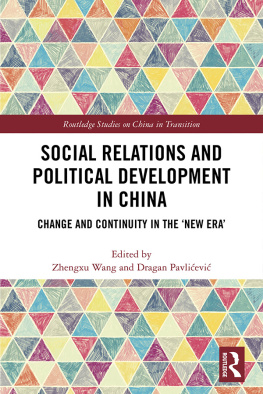The successful publication of this collection is the result of the close collaboration between Mr. Lu Xueyis students, the translator, and the colleagues at China Social Sciences Press. Thanks should be given to Ms. Gao Ge , Mr. Lus assistant, and Mr. Yan Ye , Mr. Lus student, for providing explanations and additional notes necessary for the English edition. A word of thanks should also be given to Sun Yanwen , the colleague at China Social Sciences Press, who has shown unfailing patience and offered professional support for the translation work. Special thanks should be given to Yan Peng Wittrock , the translator of this collection, for her rigorous and meticulous work and never ceasing to follow academic standards in the course of translation. She has made numerous helpful suggestions to make the English version more suitable for readers outside China, most of which have been incorporated in the final version of the translation.
Editor
Beijing, April 2019
Chinas social structure in the 21st century
The modern history of China after 1840 is a history of the Chinese peoples struggle for modernization. Building a modern society and joining the ranks of the worlds advanced nations is an ideal for several generations in China. Since 1978, our country has implemented the policy of prioritizing economic construction and carried out reform and opening up. As a result, this ideal is gradually becoming a reality. In the early 1980s, China formulated a three-step development strategy for the achievement of modernization. The first step was to double the gross national product (GNP) of 1980 and to solve the problem of food and clothing for the people. This goal was basically achieved in 1987. The second step was to double the GNP again by the end of the 20th century and raise the peoples standard of living to a moderately prosperous level. The third step was to bring the average per capita GNP to the level of moderately developed countries in 3050 years. People will enjoy a relatively well-off life by then, and a modern society will by and large be built. We are now in the midst of our endeavor to achieve the goal of building a moderately prosperous society by the year 2000. The first half of the 21st century will be a period in history when the construction of socialist modernization with Chinese characteristics in our country is brought to its completion.
The reform and opening up since 1978 has brought great progress and profound changes to the Chinese society. China is at present undergoing a period of social transformation, changing from a traditional to a modern society, from an agricultural to an industrial society, from a rural to an urban society, and from a closed and semi-closed society to an open society. Social structural transition in the transformation from a traditional to a modern society is not specific to the social development of socialist societies. It is rather a transitional phase in the process of modernization that all economically developed modernized countries have gone through. But due to Chinas special historical, cultural, and economic, as well as resource, backgrounds, the transformation of the social structure has shown a number of characteristics different from those of other countries. An important aspect of socialist modernization with Chinese characteristics is that while realizing the transition to a modern society, we need at the same time to bring about the transition from a planned economy to a socialist market economy. It is therefore necessary to first carry out a series of system reforms.
Such a close link between the transformation of the social structure and the reform of the economic system is rarely seen in the modernization processes of other countries. The transition from a traditional to a modern society, from a planned economy to a socialist market economy, structural transformation, and system reforms proceed simultaneously, together with the interweaving of structural conflicts, institutional frictions, and conflicts of multiple interests, roles, and values that have occurred during the process of transformation have made the situation more complicated and the transformation itself more difficult; not to mention the fact that this reform is taking place in a big country with a population of 1.2 billion and an unbalanced development. Thus, the difficulty, the complexity, and the arduousness involved can be easily imagined. Therefore, special emphasis should be laid on the role of stabilizing, coordinating, and innovative mechanisms in the process of realizing the transformation of the social structure and system reforms. Since 1978, the implementation of the policy of reform and opening up has forcefully propelled the process of this great historical transformation. Our experiences in the past years have proved that reform and opening up is the road we must take not only for the self-improvement of the socialist system, but also for the building of socialism with Chinese characteristics and achieving the modernization of the Chinese society.
The period from 19952010 is most critical for building a socialist modern state in China. Since 1978, we have set things right, put the focus of our work nationwide on economic construction, made the decisions on reform and opening up, formulated and implemented a series of new policies, and carried out fruitful large-scale economic and social undertakings, and in so doing laid a solid political, economic, and social foundation for realizing the social structure transformation as well as the transition of the economic system. By 2000, China will have quadrupled, or even potentially more than quadrupled, the GNP of 1980, but the per capita GNP will only be $8001,000 US, and we have only established the basic framework for a socialist market system. Therefore, the GNP should be doubled again by 2010 compared with the year 2000. By then, Chinas overall national strength will be considerable. A socialist market system will be built in all respects. The system will be improved, become mature, and be finalized, so that Chinas economic and social development will proceed on a more effective systemic foundation. However, during this period, conflicts between the two types of structures, frictions between the two types of systems, conflicts of multiple interests, and between new and old ideas will continue. Unpredictable and sudden international and domestic events will occur. All this will have an impact on our reform and development in the cause of modernization. Twists and turns, opportunities, and risks coexist. This is why we say that the years 19952010 constitute the most critical period for China in building a modern state. We have already mounted the steps of all-around economic and social development and are on the verge of crossing the threshold of joining the ranks of modernized countries.
There are a number of factors that are favorable for us in pushing ahead with our reform. First, our accomplishments since 1978 have laid a good foundation. Deng Xiaopings theory of building socialism with Chinese characteristics has won the support of the people. Building a socialist modernized state through reform and opening up has become a shared understanding of the people of all ethnic groups. One may say that our direction is now clear, the road has been opened up, and the Chinese ship heading for modernization is advancing. Second, the international environment is favorable. The Cold War pattern of US and Soviet confrontation has come to an end. A new world order is taking shape. The development of the world has come to a juncture at which the new is replacing the old. At this unusual moment of the turn of the century, time has moved in Asias favor. Many people of insight believe that the 21st century will be the century of Asia-Pacific. China is located at an important position in the Asia-Pacific. Favorable climate, geographical position, and the support of the people, together with geo-political and geo-economic advantages, have given China a chance of a lifetime. Third, China has maintained a good momentum of economic development. Thanks to the reform of the economic system and the goal of realizing the transition to a socialist market economy, Chinas comprehensive industrialization is underway. The authority concerned predicts that the period from 19912010 will be a golden age of Chinas economic growth. In these 20 years, the annual gross domestic product (GDP) growth rate will be 8.25%. By 2010, the per capita income is expected to enter the ranks of middle-income countries, up from low-income countries. Furthermore, ours is a populous country, so the overall scale of the national economy will likely leap to the forefront of the world. Foreign experts have made similar predictions: If the current momentum of development is maintained, China will become the fourth largest economy after the United States, Europe, and Japan.








